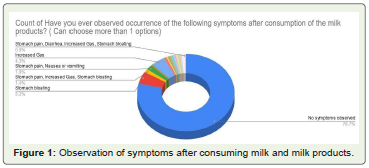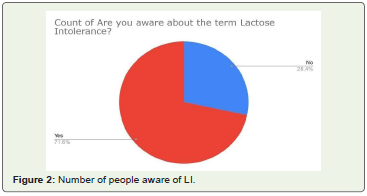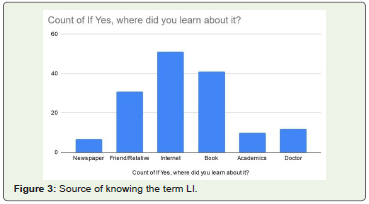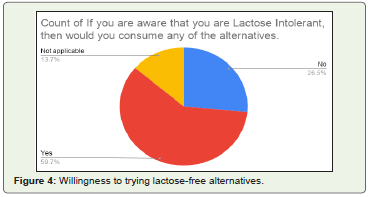Research Article
A Study on the Awareness of Lactose Intolerance among Common People in India
Diandra D* and Patil S
Department of Zoology, K J Somaiya College of Science and Commerce, India
*Corresponding author: Diandra D, Undergraduate Student, Department of Zoology, K J Somaiya College of Science and Commerce, Vidyavihar, Mumbai- 400077, India, Tel: 91-9892986644; Email: Diandra.dsa@somaiya.edu
Article Information: Submission: 27/08/2020; Accepted: 21/09/2020; Published: 24/09/2020
Copyright: © 2020 Diandra D, et al. This is an open access article distributed under the Creative Commons Attribution License, which permits unrestricted use, distribution, and reproduction in any medium, provided the original work is properly cited.
Abstract
According to statistica.com, India is the second-largest consumer of cow’s milk in the world. Milk possesses great qualities that aid digestion, metabolic
response to absorbed nutrients, growth and development of specific organs and resistance to disease, apart from these factors, it is a powerhouse of nutrients.
Many people suffer from an intolerance of a disaccharide present in milk called lactose. Some ill-effects of being unable to digest lactose is bloating, diarrhea,
nausea, borborygmi and abdominal pain. This is a sample survey of a small heterogeneous population (n=211) to understand Lactose Intolerance awareness
in India. This study aims to understand the awareness of Lactose Intolerance (LI) among common Indian people and if they can detect their symptoms
associated with LI. A survey method was used for this study.71.5% of the respondents knew the term LI. 78.7% of the respondents did not experience the
listed symptoms. 21.3% of those who observed symptoms, observed bloating apart from other listed symptoms. Also, when asked if they would try lactosefree
alternatives, 59.7% of the respondents chose yes. This may conclude that even though milk products are consumed on a large-scale in India, many do
not suffer from LI. Those suffering from common symptoms associated with LI are willing to consume the alternatives. This also shows that there is adequate
endorsement and awareness about the availability of alternatives to milk products. There is no such study available in literature, hence these results could
provide a baseline data for further research in this area.
Keywords
Lactose Intolerance; Milk products; Symptoms
Introduction
Lactose is the disaccharide made up of galactose attached to
glucose and is of utmost value in animals. The brush-border enzyme
lactase must hydrolyse the monosaccharides in order to absorb
lactose. The enzyme lactase is present along the microvilli of the small
intestine enterocyte [1]. An essential source of energy in a breastfed
child is the lactose present in mother’s milk [2].
Lactose Intolerance is defined as “Lactose malabsorption with
gastrointestinal symptoms.”
Also, Lactose Malabsorption can be defined as: “Not all ingested
lactose was absorbed and that some has reached the large intestine.”
The common symptoms associated with the maldigestion of lactose
are bloating, diarrhoea, nausea, borborygmi, and abdominal pain.
Due to the mix-up between the terms LI and Cow’s milk allergy
(CMA), there is a possibility of misidentification of the condition [3].
Lactose Intolerance depends on self-diagnosis based on symptoms
after consuming lactose, but deficiency and malabsorption must
be tested unbiasedly. If patients with primary hypolactasia and
lactose intolerance can be distinguished, it would be advantageous
for diagnosing and treating the condition, but this is not yet very
accessible clinically [4]. There are four ways by which deficiencies can
potentially hint to intolerance to lactose:
1. Primary lactase deficiency: It is also known as lactase
non-persistence. This form of deficiency is seen in the majority of
the people. Usually, after the age of two, there is a reduction in the
production of lactase. Those suffering from this condition observe the
symptoms during puberty. Those who have inherited the genes for
primary lactase deficiency also observe the ill-effects.
2. Secondary lactase deficiency: It can occur from any damage
caused to the small intestine. An underlying condition, if treated, can
be beneficial to overcome the intolerance.
3. Developmental lactase deficiency: This form of deficiency
is seen in premature infants. However, this is seen for a small period
after they are born.
4. Congenital lactase deficiency: This is a rare condition,
where there is no production of lactase in the small intestine since
birth. Those who inherited the genes for this condition are the ones
who experience this condition [5]. However, often, those ignorant
of their intolerance towards lactose may experience Irritable Bowel
Syndrome (IBS) like symptoms [6]. Lactose intolerance persists
throughout life; it can be short-lived due to an infection in the jejunal
mucosa. Lactase persistence is another term that means: “The ability
of adult humans to digest the milk sugar lactose - lactase persistence
- is a dominant Mendelian trait” [17].
LI is common in some parts of the world. In Middle Eastern,
European, African, and Southern Asian individuals, as Lactase
persistence is a genetically determined trait, there is a sustained
lactase production even through adulthood [7]. Indians are reported
to have a better tolerance to lactose as they are known to include milk
products in their everyday foods [8] India is also the major consumer
of milk products in the world. Here, the individual whose body is
accustomed to lactose consumption can enjoy more dairy [3].
The treatment for LI should be governed on how severe the
intolerance is [9] Most of the world’s milk is obtained from cows,
while buffalo, goat, sheep, and camel milk are least consumed [10].
Some alternatives that can be consumed as a replacement to cow’s
milk include almond milk, oat milk, coconut milk, cashew milk and
rice milk. But there are discussions if these kinds of milk should be
addressed as ‘milk’ or ‘beverages or juice or drink’[11]. Even then,
these alternatives can be safely consumed by lactose-intolerant people
because they do not contain lactose but provide similar flavour and
texture to the palate. Various forms of fermented dairy foods can
provide the necessary nutrients without causing any ill-effects [9].
Lactose intolerance can be examined based on a patient’s history
as well as the management of the diet [1]. In some countries, where
lactose intolerance is widely prevalent, the lactose-free industry
is significantly developing [6]. However, complete elimination of
lactose from the diet can be damaging to health. A vital method to
control LI symptoms is to apply nutritional tactics such as reducing
or eliminating lactose consumption from the diet. Hence, patients are
advised to go the extra mile and check the ingredients of the foods
they consume [12]. When lactose is reduced from the diet, Vitamin D
and calcium levels are lower than the daily requirement making the
elderly prone to declined bone density [6]
Therefore, it is essential to increase awareness of Lactose
Intolerance among the common Indian population. With the basic
knowledge about symptoms and use of alternatives of milk, LI can be
significantly reduced. In this study, we aim to understand if common
people learn that they could be intolerant to lactose by self-assessing
their condition after consuming dairy products and if people can
relate the mentioned symptoms to the consumption of milk products.
Awareness of symptoms of LI and the available alternatives to milk
can help people to reduce their symptoms.
Methods and Materials
Sampling:
As this study is a small representation of India’s populations, we have used the random selection method. The survey was conducted between 6th January 2020 and 21st June 2020 by way of a structured questionnaire to collect the data for the primary analysis. The survey was sent to 240 people, out of which 211 responses were chosen/selected for further analysis of the data. The remaining 29 responses
were eliminated as they were incomplete or repetitive. The survey contained 13 questions that included the demographics, if they consume milk and milk products daily, the milk products they consume if they are aware of Lactose Intolerance and the source of information. They were also asked if they would consume the alternatives to milk products (almond milk, oat milk, tofu, groundnut curd). However, three questions were eliminated from the survey as they did not render any relevance to the other questions on further study. Most questions were multiple-choice based, and few were open-ended. The survey was conducted on an honorary basis.Statistical Analysis:
The statistical analysis was formulated with the graphs and piediagrams supplemented with Google Sheets and MS Excel.For analysis, secondary data was collected from research articles, newspapers and journals.
Analysis
Observation of the symptoms:
The general symptoms associated with Lactose Intolerance
in the survey’s population included bloating, diarrhoea, nausea,
borborygmi, and abdominal pain.These symptoms were also included in the questionnaire, for
the respondents to identify themselves as lactose intolerant. The
pie-diagram below describes the occurrence of symptoms after the
consumption of dairy products. Only 0.9% respondents identified
chose was for stomach pain, bloating, diarrhoea and increased gas,
followed by 1.4% identified stomach pain, bloating and increased gas,
1.9% said they experienced stomach pain and nausea. Some members
under the survey identified only one of the mentioned symptoms after
consumption of milk products. 4.3% observed increased gas and 5.2%
of the people experienced stomach bloating. Given that, the majority,
i.e., 78.7% of respondents observed no symptoms after consuming
milk and milk products.
Awareness of Lactose Intolerance:
The survey was intended to evaluate the awareness of respondents
towards LI. This observation has been represented in the form of a bar chart below gives. 60 or 28.4% of the respondents were unaware of the
term, while 151 or 71.6% claimed that they know the term LI.
Along with knowing the term, we aimed at identifying where the
responders learned about LI. The diagram below shows the various
sources of knowing the term. The majority, i.e., 33.6% respondents
learned about LI from the Internet, while 27% learned from a book,
and 20.4% respondents learned from their friend or relative about LI.
Only seven respondents learned about LI from a newspaper.
Agreement to try Lactose-free alternatives:
Those suffering from LI can include lactose-free alternatives in
their diet, including almond milk, oat milk, cashew milk, coconut milk,
groundnut curd, and tofu. The pie diagram shows the respondents
willing or unwilling to try the alternatives. 126 or 59.7% people agreed
to try lactose-free alternatives. 56 or 26.5% of the respondents were
reluctant to try the alternatives, while for 13.7% of the respondents,
this question was not applicable.
However, to get a better understanding of the above question, we
filtered the responses into two categories:
1. Those who experience symptoms and are willing to try the
alternatives.
2. Those who experience symptoms and are unwilling to try the
alternatives.
We concluded that when trying to inculcate Lactose-free
alternatives to the people with symptoms, 71.1% agreed to try them.
Nevertheless, 28.8% of the self-identified lactose Intolerant
respondents were reluctant to try the alternatives.
Reasons not to consume Lactose-free alternativess:
When asked to state the reasons for not opting for the lactosefree
alternatives, we considered the respondents who experienced
symptoms. 50% of the respondents refused to consume the alternatives
due to the taste; 33.3% chose not to eliminate milk from their diets
while the remaining 16.7% respondents assumed that consuming the
lactose-free alternatives would be harmful.Results
As seen in Figure 1, 78.7% of the respondents did not observe
any symptoms after consuming milk and milk products daily.
However, 21.3% of people experienced symptoms. Out of the 21.3%
who experienced symptoms, increased gas was the symptom most
observed, followed by stomach bloating.
When considering the awareness of LI, 151 respondents knew the
term. Though, we are not sure that the respondents were fully aware
of the LI and its implications or have heard the term. They were also
observing Figure 2, it is evident that 60 respondents are unaware of
the term LI. In (Figure 3), we can note the various sources of knowing
the terms. The most voted source was the Internet, followed by book
and the least voted was Newspaper.
Figure 4 shows us the willingness of the respondents to try lactosefree
alternatives.59.7% of the respondents answered positively to try
the lactose-free alternatives, while 26.5% of the respondents would
not consume the lactose-free alternatives (Table 1).
Table 1: Plant-based alternatives to milk [14].
When considering the respondents who experienced symptoms
and did not choose to try the alternatives, the top reason was the taste
of the alternatives.
Discussions
It is now evident from the results that LI awareness is quite
common in India (71.6%). However, as this study is only a small
representation of people in India, it is not a sure fact that many are
aware of LI. Also, we are unsure if awareness of the term implies that
the respondents know about the ways to diagnose the condition and
take proper measures to reduce their symptoms. A previous study on South American Indians conducted in 1969, showed that about 58.3%
of the subjects observed digestive symptoms after consuming 50 g
of lactose diluted with 500 ml of water. The authors concluded that
lactase deficiency was commonly seen in the subjects of Indian descent
[13]. This shows that this observation is not true for the common
Indian population living in India. Also, many respondents did not
complain about ill-effects after consuming dairy products, Indians
are not very prone to LI. We are unsure if the symptoms are due to
consuming milk products or due to a prolonged condition. Many of
the respondents were willing to try lactose-free alternatives. India is
a geographically and culturally diverse country. As stated before, this
study is a small representation of the Indian population, irrespective
of the region they belong to; the number of people suffering from
LI can differ in different regions of India. For the small percentage
of people that can be suffering from LI, there are not many options
available in the Indian market to replace the milk in their diet.
Cow’s milk is the most popular and contributes to 83% of the
global consumption, while buffalo milk contributes to 13%, goat
milk contributes 2.3%, while sheep milk contributes 1.4% and camel
milk contributes 0.3%. Nutrition-wise, buffalo milk contains higher
amounts of fat and provides added energy as compared to cow milk.
Goat milk contains the amounts of lipids and proteins like cow’s milk
but is lacking vitamin B12 and folate. Milk obtained from sheep has
more lipids, proteins and lactose compared to cow’s milk [15].
Lactose-free alternatives for those suffering from LI:
For people suffering from LI, consuming dairy-free alternatives
could help them avoid the symptoms. But often these alternatives
are very difficult to find or simply not suitable to their taste buds.
Nevertheless, over-the-years, there is a development in the lactosefree
industry.Plant-based alternatives:
These alternatives are prepared using water and the plant-based
substance by homogenizing the mixture, which makes it resemble
cow’s milk. The plant-based alternatives are of five types, such as [14].Among these kinds of milk, almond milk has been a part of the
diets of many in North America, European Union, and Australia and
hence is considered the most popular alternative. Soy-incorporates
foods are known to be consumed on a large-scale in South Asian
countries. Those who are allergic to soy and almonds can consume
rice milk [11]. To increase the shelf-life of plant-based milk, heat
treatment is an old-method to prevent it from spoiling faster. In terms
of the nutritional value of these kinds of milk, it is different in every
kind. Combining two plant-based milks can add to its nutritional
value.
To those concerned about not meeting their daily calcium
requirements, companies are enriching the milks with additional
calcium [14]. Another possible alternative for the lactose intolerant is
the consumption of lactase tablets and drops as it contains the enzyme
lactase that can minimize the risk of developing symptoms [1].
Milk supplemented with bacterial strains like Bifid bacteria and
Lactobacillus acidophilus can enhance its nutritional properties
considerably [16].
Future perspective of LI:
LI is already well-known, but the term must be included in the
educational curriculum to make it known on an even larger scale.
When the awareness is made to a bigger audience, the diagnosis and
prevention will also increase significantly. This will help eradicate or
reduce the symptoms associated with LI to a greater extent.As the lactose-free product industry is just developing in India, an
increase in affordable lactose-free alternatives will ensure all types of
people purchase, consume and avoid the symptoms.
However, if a survey, along with clinical testing of the condition
is conducted in various regions in India, it could help the medical
professionals understand the types of symptoms and give better
treatments to Indian populations. More research about LI in Indians
living outside India, their dietary and environmental changes can
help us establish a broader demographic about LI among people of
Indian descent.





